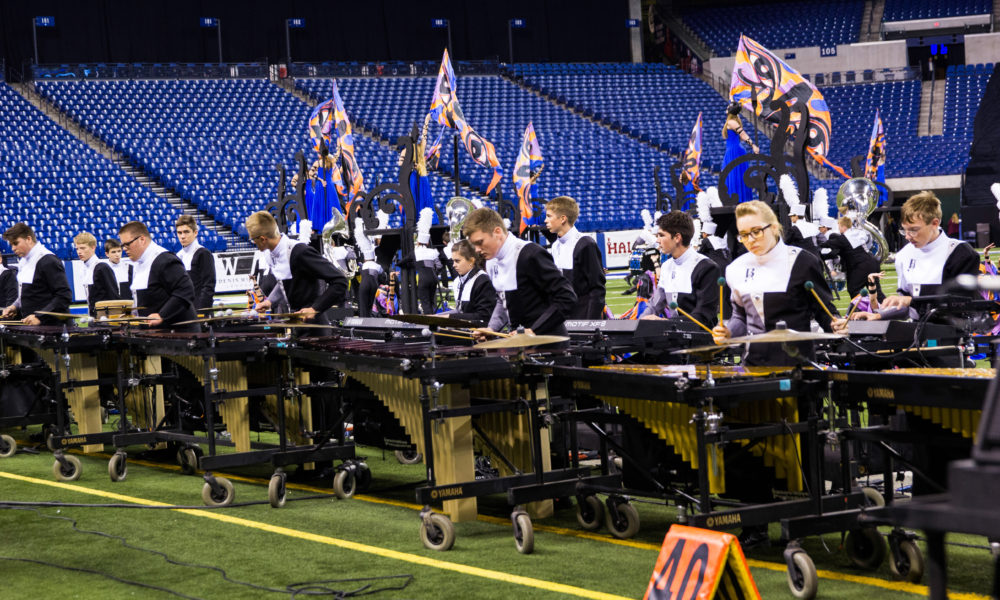Sponsored by: 
Say goodbye to timing penalties. Learn how to move fast and stay safe while setting up your front ensemble/pit equipment for drum corps, marching band, and indoor drumline.
As a group enters a gym or stadium in competition, emotions and nerves are running high. For the pit, or front ensemble, the pressure is amplified by a large amount of equipment that needs to be put into place while time limits or penalties are looming. Here are some tips to stay calm under pressure for speedy and safe pit setup.
Learning a Layout
So what goes where? Some groups vary from year to year while others have standard positions for their pit equipment.
“Different teachers and designers have different ideas on how to do that,” says Adam Wiencken, percussion specialist with the Broken Arrow (Oklahoma) Bands. “We had some younger kids in the pit, so it’s just easier for us to put like instruments with each other. This year it was really about the kids and how to set them up for the best possible listening environment to succeed!”
Often the musical arrangement as well as practical concerns like electrical cords are taken into consideration.
“As far as where the drum set or the rack goes, everything has its place for a different reason,” says Mike Bishop, front ensemble coordinator for the Crossmen Drum and Bugle Corps and the front ensemble arranger for the George Mason University Indoor Drumline. “It could be a timing thing. It just depends on how the music is written and what you’re looking for visually and sonically for your group.”
Practice Makes Perfect
Rehearsing the on/off field routine is important for all front ensemble students as well as any staff members or parents that will be helping. Try to limit the number of non-performers as much as possible for safety and clarity.
“The kids know the equipment better than anyone else, so you need to trust them to handle their own stuff, and teach them how to care for it, of course,” Bishop says. “They’re working with it every day, and they know it better. What you just need the parents for is the heavy lifting on the big things that I don’t want the kids to be exerting themselves too much on before a performance.”
Some of the bigger items for parents to transport include speakers, electronic carts, concert bass drums and gongs.
Once all responsibilities are doled out, start practicing about one week before the first competition. “You don’t want to practice it any earlier than that because things will change, and you won’t know what you’re doing,” Bishop says.
Dedicate some rehearsal time to practicing the loading routine with everyone. “We will get everything in order, do a slow walkthrough, go through that process, and then we just repeat it and try to make it faster and more efficient,” Wiencken says. “We practice four to five times, time it and try to make it as short as possible without being out of control.”
When in Crisis Mode
In the unfortunate situation that someone gets hurt or something doesn’t work, make sure you’re prepared. Bishop has a small backpack filled with extra cables and other miscellaneous supplies that might be needed at the last second.
“The most important thing to remember is to stay calm,” Bishop says. “You have to make sure that no matter what’s going wrong, you seem like it’s going to be all right. They’re going to turn to you when something happens. It’s a scary moment when you don’t have sound. There’s going to be a lot of pressure on you, and the best thing you can do is to stay calm for the kids.”
Avoid the $10,000 Table
When moving pit equipment, never place other instruments, personal items or really anything on top of the large instruments, especially mallet percussion.
“From day one they know that nothing goes on those keys; I don’t even let them put the music on the keys,” Bishop says. “The only things that touch the keys are the covers, and the moment when the mallet actually hits a key while playing.”
Some students will need frequent reminders despite your best efforts. “I like to walk by and say, ‘Hey, that’s a $10,000 table you’re putting that drum pad on,’” Wiencken says. “That’s kind of how I do it. I don’t scold, and I would never talk to a parent like that, but for the kids, they know better. It’s never good for the instrument to set a bunch of heavy equipment on it.”
While the performance is important, the safety of the students and any helpers must come first. The more precise and routine your setup strategy, the safer it is for all involved.
“From day one they’re instructed about how to move the equipment for their safety and the betterment of the equipment,” Wiencken says. “The system is set up that you don’t have to panic, go that fast, or sprint or anything crazy, as long as you’re organized.”
Photo by Vicki Webb


